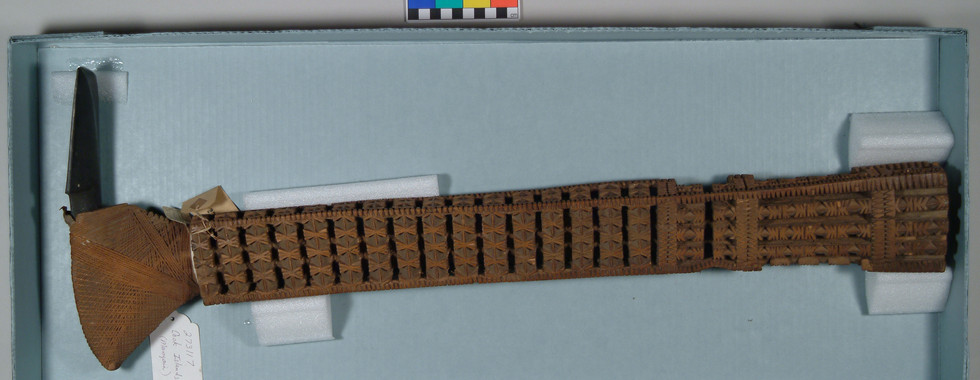2008 Regenstein Intern Heather Radke introduces Captain A.W.F. Fuller, collector of over 6,500 Pacific items now cared for by the Field Museum.
A selection of Fuller Collection items.
In 1958, Roland Force made a journey to London with his wife Maryanne (a respected anthropologist in her own right,) to sit down with Fuller and discuss the artifacts he was giving to the museum. He brought with him a Walkie Record-All, the cutting edge of portable recording technology at the time.
Every day from noon until three o’clock in the morning, the two men sat down and went through each object in the collection, listing off the date, the type of object, giving a description, telling who sold it to whom, and occasionally telling an anecdote or bickering about provenance.
Their 160 hours of commentary were recorded on plastic belts called sonobands, a medium that would become obsolete only a few years later. Typed transcripts of their conversations were made from these recordings by Maryanne Force.
These transcripts were ultimately used to help publish a catalog entitled The Fuller Collection of Pacific Artifacts. The purpose of this catalog was “to give the collection the prominence it deserves and to pay tribute to the collector” (Force and Force 1971: vii).
The sonobands themselves were then packed away in a small cardboard box, and stored in the Archives of the Field Museum for more than forty years.
However, in 2003, the Field Museum hired The Cutting Corporation (now the Audio Preservation Lab at Graphic Audio), a firm in Bethesda, Maryland. As specialists in the preservation of archival audio material, they could transfer the sonoband recordings to digital format.
We carefully packed and shipped off the approximately 150 sonobands along with the two Walkie Record-All machines that Roland Force had used back in 1958.
The Cutting Corporation was able to capture the old analog sonoband recordings in WAV format so they can now be heard for many generations to come.
2008 Regenstein Intern Katie Good describes the Fuller Sonoband project.
Photos by Jackie Pozza.
Gary Bergland and his daughter, Malia Beal, visited the Museum in December in order to donate a collection of Samoan items. Gary Bergland and his late wife, Mary Jo Bergland, were employed in American Samoa in the 1960s at the Samoan Education Television Project and the American Samoan Department of Agriculture, respectively. The materials they collected and brought back to the US make a significant contribution to the Museum’s collection, which is primarily composed of both earlier and later items from Samoa’s history.
Before accepting a donation offer, the Museum collects as much information as possible from the donor, and staff must carefully consider what “story” the objects therein can tell. For collections to have research and cultural value for posterity, it is crucial that they be well documented, with proper provenience, information about the items’ makers, and object histories. The Berglands’ collection comes to us with photographic and written documentation, as well as the history of the collection from Gary Bergland himself.
Highlights of the 45 piece collection include upeti, or pattern boards, which are used to print designs on barkcloth (commonly known as tapa, or siapo in Samoan), as well as examples of tapa printed from these boards. Mr. Bergland, a hobby photographer, provided photos of an artist creating one of the siapo, from the stage of bark-beating to painting decorations. There is also a fine mat, or ‘ie Samoa, a type of mat that has recently been recognized by UNESCO as a work of Intangible Cultural Heritage. ‘Ie are intricate and time-consuming to make; as such, they are given as gifts of high honor. Mary Jo Bergland was given this mat as a goodbye present from the Samoan community in which she worked.
“Our hearts are happy knowing the Samoan pieces are with the Field,” says Beal.















































